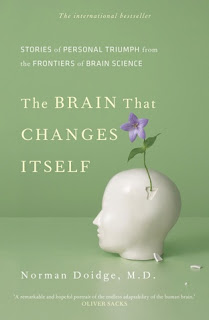 "It is a plastic, living organ that can actually change its own structure and function, even into old age. Arguably the most important breakthrough in neuroscience since scientists first sketched out the brain’s basic anatomy, this revolutionary discovery, called neuroplasticity, promises to overthrow the centuries-old notion that the brain is fixed and unchanging. The brain is not, as was thought, like a machine, or “hardwired” like a computer. Neuroplasticity not only gives hope to those with mental limitations, or what was thought to be incurable brain damage, but expands our understanding of the healthy brain and the resilience of human nature.
"It is a plastic, living organ that can actually change its own structure and function, even into old age. Arguably the most important breakthrough in neuroscience since scientists first sketched out the brain’s basic anatomy, this revolutionary discovery, called neuroplasticity, promises to overthrow the centuries-old notion that the brain is fixed and unchanging. The brain is not, as was thought, like a machine, or “hardwired” like a computer. Neuroplasticity not only gives hope to those with mental limitations, or what was thought to be incurable brain damage, but expands our understanding of the healthy brain and the resilience of human nature.Norman Doidge, MD, a psychiatrist and researcher, set out to investigate neuroplasticity and met both the brilliant scientists championing it and the people whose lives they’ve transformed.
The result is this book, a riveting collection of case histories detailing the astonishing progress of people whose conditions had long been dismissed as hopeless. We see a woman born with half a brain that rewired itself to work as a whole, a woman labeled retarded who cured her deficits with brain exercises and now cures those of others, blind people learning to see, learning disorders cured, IQs raised, aging brains rejuvenated, painful phantom limbs erased, stroke patients recovering their faculties, children with cerebral palsy learning to move more gracefully, entrenched depression and anxiety disappearing, and lifelong character traits altered.
Doidge takes us into terrain that might seem fantastic. We learn that our thoughts can switch our genes on and off, altering our brain anatomy. Scientists have developed machines that can follow these physical changes in order to read people’s thoughts, allowing the paralyzed to control computers and electronics just by thinking. We learn how people of average intelligence can, with brain exercises, improve their cognition and perception in order to become savant calculators, develop muscle strength, or learn to play a musical instrument, simply by imagining doing so.
Using personal stories from the heart of this neuroplasticity revolution, Dr. Doidge explores the profound implications of the changing brain for understanding the mysteries of love, sexual attraction, taste, culture and education in an immensely moving, inspiring book that will permanently alter the way we look at human possibility and human nature.
Dr. Norman Doidge introduces principles we can all use to overcome brain limitations and explores the profound brain implications of the changing brain in an immensely moving book that will permanently alter the way we look at human possibility and human nature."
Source: http://www.normandoidge.com/normandoidge/ABOUT_THE_BOOK.html
An interesting fragment:
"Plasticity requires that we re-examine culture, too. Most think the relationship between the brain and culture is a simple one: The human brain produces culture. In fact our culture also moulds our brains. Just as children with learning disorders can develop new processors, different cultures cultivate different kinds of brains, en masse. The Sea Gypsies, a tribe off the coast of Thailand, learn to see clearly underwater, diving 10 metres in their hunt for food — an example of a whole culture that has developed a super-sense.
As Richard Nisbett shows in The Geography of Thought, when Asians look at still life pictures they see the relationships between the objects very clearly, but the main object less clearly. Westerners see the opposite. These perceptual differences are not based on a difference of opinion about what to focus on, but on involuntary, unconscious brain processing wired into the subjects by their culture, and alterable by emigration. Thus many of the differences between cultures and civilizations need not be seen as based on either genetic (biological) or 240603_f260experiential differences. Cultural experience shapes biology, and no doubt biology shapes cultural experience. These discoveries promise to reshape, in the most profound way, our understanding of cultural acquisition, conflicts, immigration tensions and even the rates at which we, in a globalized world, can expect each other to change."











Cap comentari:
Publica un comentari a l'entrada
Què t'ha semblat el post? (Només s'acceptaran comentaris d'usuaris registrats)